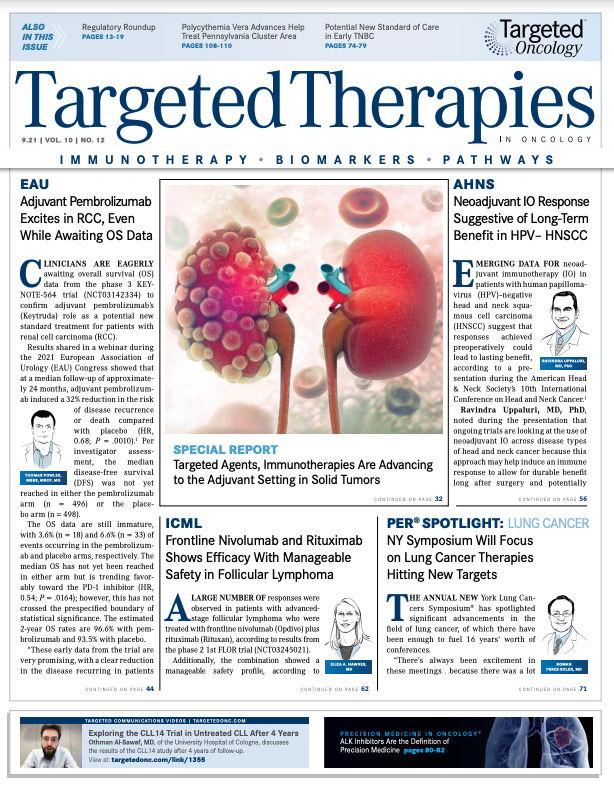Neoadjuvant Apalutamide Does Not Affect Robotic Prostatectomy Efficacy
A study has confirmed that androgen receptor inhibition did not complicate robotic prostatectomy surgical outcomes in patients with prostate cancer.

An analysis of the phase 2 NEAR trial (NCT03124433) presented at the 2021 Annual European Association of Urology Congress confirmed that androgen receptor inhibition did not complicate robotic prostatectomy surgical outcomes in patients with prostate cancer.
“Neoadjuvant androgen deprivation therapy has been previously reported to complicate prostatectomy; [however, data on the effect of] neoadjuvant apalutamide prior to robotic prostatectomy has not been described,” Xinyan Yang, MBBS, said in a presentation of the data. “We did not encounter any difficulty because of the neoadjuvant therapy; there was no excessive blood loss and there were desmoplastic changes in the tissue that made the surgery more difficult than usual.” Yang is a medical officer and resident at Singapore General Hospital.
The NEAR trial enrolled 25 patients with biopsy-proven, organ-confined prostate cancer. Patients with intermediate-risk to high-risk disease, as defined per D’Amico criteria, were recruited. Neoadjuvant apalutamide (Erleada) was administered at a dose of 240 mg daily for 12 weeks, after which all patients underwent robotic radical prostatectomy with pelvic lymph node dissection. Yang noted in a discussion that investigators did not perform the surgical technique differently than their routine procedure for this patient population and began with a bilateral seminal vesicle dissection.
Neoadjuvant apalutamide resulted in a statistically significant reduction in serum prostate-specific antigen (PSA) levels over a 12-week duration of treatment (P < .0001). After prostatectomy, there was a further reduction in PSA levels that was also deemed significant (P = .001). Moreover, mean quality-of-life scores based on the European Organisation for Research and Treatment of Cancer Quality of Life Questionnaire Version 3.0 were not significantly reduced (P = .08).
After prostatectomy, 40% of patients had grade 3 or higher disease per the International Society of Urological Pathology (ISUP) guidelines and all patients had at least stage pT2c disease. The mean nodal yield was 24 (range, 4-49) and 73% of patients had negative margin status. Positive surgical margins were found in 3 patients (27%).
Regarding node status, 70% (n = 21) of patients were N0 and 4 patients were N1. In terms of PSA response after surgery, 84% were at nadir level (0.5 ng/mL) and 16% were above nadir level.
Data from the NEAR trial were compared with outcomes from prospective analysis of a multiracial Asian population of patients from a single institution who underwent prostatectomy without neoadjuvant apalutamide (n = 725). In terms of perioperative outcomes—estimated blood loss (EBL), length of stay (LOS), catheter time, and complication rates—findings showed that prostatectomy with neoadjuvant apalutamide produced similar outcomes.1,2
The mean EBL was 198 mL (range, 50-400) in the neoadjuvant apalutamide study, compared with 215 mL (range, 10-2000) in the study of patients without neoadjuvant apalutamide. The mean length of stay in both groups was 3 days.1,2
The mean catheter time was 8 days (range, 3-14) for patients who received neoadjuvant apalutamide vs 7 days (range, 3-72) in those who did not. By Clavien-Dindo classification, in patients who received neoadjuvant apalutamide, 80% had postoperative events classification of 0 compared with 78.5% of patients not treated with neoadjuvant apalutamide. Similarly, 20% of patients in the neoadjuvant apalutamide group reported a score of 1 or 2 vs 17.6% in the group that did not receive adjuvant therapy. Finally, 0 patients who received neoadjuvant apalutamide had a Clavien-Dindo classification of 3, 4, or 5, compared with 3.8% in those who underwent surgery alone (P < .05).
Yang presented a case study of a 71-yearold Chinese man with no past medical history. The subject had D’Amico high-risk disease with a preoperative serum PSA of 43 μg/L. The patient also had a Gleason score of 4+4 via biopsy (ISUP grade 4) with clinical T3b bilateral disease.
The subject’s multiparametric MRI showed significant disease involving both prostatic lobes, with possible right extracapsular extension and involvement of the root of the right seminal vesicle and neurovascular bundle. Surgery began with a posterior dissection, delivering both seminal vesicles and the left vas deferens. The rectoprostatic fascia was incised and the rectum was dissected free. The surgical planes of dissection were preserved despite 12 weeks of neoadjuvant apalutamide, with no increase in tissue desmoplastic reaction.
Pedicle ligation was performed using Hem-o-lok clips. Yang said that to improve postoperative continence rates, an apical dissection— which preserves adequate urethral length—was performed.
Further, nodal dissection was performed routinely and bladder neck reconstruction was conducted using a posterior racket in handle fashion. The vesicourethral anastomosis suture method, a running belt hub and suture to ensure watertight apposition, was also used during reconstruction.
Upon histological examination of the specimen, ypT3bN1 and ISUP grade 4 disease were present, Yang reported. Of the 47 lymph nodes, 2 were positive for adenocarcinoma. The postoperative PSA level at 4 weeks was under 0.03 μg/L. “Perioperative outcomes are comparable to a historical series without neoadjuvant therapy,” Yang concluded, noting that “neoadjuvant apalutamide is well tolerated but associated with a reduction in libido.”
REFERENCES
1. Yang XY, Tiwari R, Aslim EJ, et al. Intense androgen receptor inhibition with neoadjuvant apalutamide does not complicate robotic prostatectomy outcomes. Presented at: 36th Annual European Association of Urology Congress; July 8-12, 2021; virtual. Abstract V41. Accessed July 12, 2021. https://virtual.uroweb.org/resource-centre/ EAU21/222528/Abstract/
2. Alvin LWX, Gee SH, Hong HH, et al. Oncological outcomes following robotic-assisted radical prostatectomy in a multiracial Asian population. J Robot Surg. 2015;9(3):201-209. doi:10.1007/s11701-015- 0516-1

Survivorship Care Promotes Evidence-Based Approaches for Quality of Life and Beyond
March 21st 2025Frank J. Penedo, PhD, explains the challenges of survivorship care for patients with cancer and how he implements programs to support patients’ emotional, physical, and practical needs.
Read More